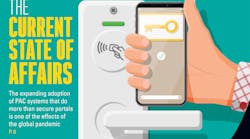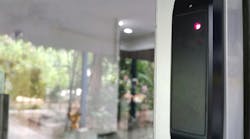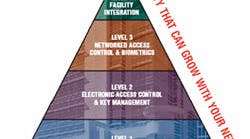This article originally appeared in Access Control Trends & Technology, an annual bonus publication to Security Business magazine and Security Technology Executive magazine.
Many security professionals who focus primarily on small one- or two-door access control jobs have come to realize that less can, in fact, be more. Although elaborate access control projects can be more lucrative, they require a larger investment in time for setup and training. Consequently, savvy security pros who take on the smaller jobs can remain as profitable and competitive as larger integration companies by focusing on this one- and two-door market niche.
It's a known fact that of the 80-20 rule, 80% of access control systems cover fewer than eight doors. And now with the availability of door controllers that use apps, there’s no need for extra computer hardware or subscription-based software to maintain simple access control applications.
Enterprise-level access control systems simply can’t get down to a price level of controllers that use smartphone apps. In reality, most end users just don’t have to have nearly 90% of the capabilities of an enterprise system, which makes a simple app-based door controller a much better fit for their requirements and their budget.
Certain end users typically require single- or two-door installations – those who have to share a restricted space and who want access control features that aren’t provided by simple key locks. One-door access systems often are implemented for single-room or single-unit environments in shops, condos, apartments, garages, or warehouses. Electronic access control can add and delete user access to a building or yard while providing defined schedules and a historical audit trail for reporting.
A one-door access control system can be used either as a stand-alone system or as one that’s integrated with a larger access control system through different communication interfaces, such as TCP/IP, RS232 or other wireless technologies. Demand for stand-alone or integrated systems really depends on the marketplace and application, but networked systems require a substantial investment, whereas a stand-alone system can be implemented within hours. Integrated networks deliver a higher level of security where intrusion, elevator control, audio communication and visual surveillance systems are necessary. The majority of small systems don’t require those extra layers of security.
Single-Door Components
Ideally, a single door access control system should include an electric door lock, a controller, an entry reader and an exit reader, a door-position switch and a robust battery-backup power supply. As referenced above, communication ports should include RS232, RS485, USB, TCP/IP or other wireless protocol interfaces to facilitate integration with a networked access control system as necessary and to allow for potential expansion. In addition, a single-door access system should include alarm annunciation via audio speakers or alarms or strobes and be easy to install and to operate.
Essentially, all the features of a single-door system are the same as those of a two-door system, but with the added capability of creating a mantrap or interlock system where one door must be closed before the other door can be opened.
And, given the increased demand for Bluetooth readers and mobile credentials, one- and two-door access systems today should be able to support various reader types, particularly mobile smartphones that use BLE or Wi-Fi, in addition to biometric, proximity and keypad credentials.
Manufacturers over recent years increasingly have rolled out various business models for Bluetooth readers. Some require a yearly subscription or charge per credential to the user, and others are available at no charge to the end user. Unfortunately, the acceptance and adoption of Bluetooth readers have been colored by conflicting information that’s been somewhat confusing to installers and end users as to the real cost and benefit of implementing the technology.
However, given all the technological advances packed into a modern smartphone, smartphone readers likely will become the norm fairly soon. Bluetooth is only one of many wireless protocols being developed for smartphones. Multilevel authentication — using a combination of something the authorized user has, knows and is as credentials —also is built into the system by using a high-end smartphone because smartphones can open through the use of facial recognition or a fingerprint along with a PIN before an app can be used.
Furthermore, the prevalence of smartphone apps has enabled the industry to leverage the processing power of smartphones to provide encrypted authentication to a reader that’s wired to an access point. The same technologies used for tracking smart tags for Apple or Samsung phones are being developed for access control applications. Through the use of apps, it now is possible to harness the capabilities of a computer, so single- or double-door controllers no longer require a dedicated computer and all its accompanying hardware and software — and personnel to manage it — to configure the controller.
Secure Your Success
Security technicians and locksmiths who serve the single- and double-door market should know the unique advantages of access control capabilities versus a key lock to comfortably and confidently demonstrate the benefits to their customers. Having simple low-voltage wiring skills and awareness of the types of power that can be used will prove beneficial to the security pro.
To increase sales, they should convey to their prospects that there are new, innovative and low-cost means of providing simple access control without the necessity to learn complex software on a computer. Apps are designed to be intuitive, which allows authorized personnel to use their own smartphone to configure the controller, add or delete users, set schedules and even enable their users, such as tenants or employees, to use their smartphone as an access credential.
Choosing a strong access control technology manufacturer also is critically important. The products they offer should meet all federal regulatory requirements, including FCC and UL for power supply. All of their resource material should be free and also meet all federal regulatory guidelines. A true and trusted access control vendor partner should deliver superior technical support, product delivery and a top-notch warranty.
Many opportunities abound in small access control applications. Indeed, they can translate into big business and prove that less absolutely can be more.







